#adélaïde de savoie
Text
"To all intents and purposes she may be counted among the kings of France"

The hour that struck the death of Louis VIII was arguably the most critical in the history of the Capetian family. The new king, one day to be St Louis, was still a child. The trend of events in the previous two reigns had brought the higher nobility to realise that its independence would soon be seriously threatened. But a unique opportunity was raised to the regency of the queen-mother, Blanche of Castile, on the pretext that she was a woman and a foreigner. Yet this was not the first occasion on which the king's widow had acted as regent, nor the first on which a queen had played a part in politics. Philip Augustus had been the first Capetian not to involve his wife in the government of his realm. Before his time the queens of France had often intervened in affairs of state. Constance of Arles, not content with making married life difficult for Robert the Pious, had wanted to change the order of succession to the throne. She had led the opposition to Henri I, provoking and upholding his brothers against him, and she was perhaps responsible for the separation of Burgundy from the royal domain, to which Robert the Pious had joined it. Anna of Kiev, after the death of her husband Henri I, had been one of the regents, and it was only her second marriage, to Raoul de Crépy, that took her out of politics. Bertrada de Montfort's influence over Philip I had been notorious, and so had her hostility to the heir to the throne, whom she had even been accused of trying to poison. Adelaide of Maurienne, despite a physical personality before which Count Baldwin III of Hainault is said to have recoiled, had held considerable sway over Louis VI, procuring the disgrace of the chancellor, Etienne de Garlande, and egging on Louis to the Flemish adventure from which her brother-in-law, William Clito, was to profit so much. Eleanor of Aquitaine- as St Bernard had complained- had more power than anyone else over Louis VII as long as their marriage lasted. Louis VII's third wife, Adela of Champagne, had appealed to the king of England for help against her son Philip Augustus when he had sought to free himself of the tutelage of her brothers of Champagne. Later, reconciled with Philip, Adela had been regent during his absence from France on crusade. From the beginnings of Capet rule, the queens of France had enjoyed substantial influence over their husbands and over royal policy.
But Blanche of Castile was to play a greater role than any of her predecessors. To all intents and purposes she may be counted among the kings of France. For from 1226 until her death in 1252 she governed the kingdom. Twice she was regent: from 1226 to 1234, while Louis IX was a minor, and from 1248 to 1252 during his first absence on crusade. Between 1234 and 1248 Blanche bore no official title, but her power was no less effective. Severe in personality, heroic in stature, this Spanish princess took control of the fortunes of the dynasty and the kingdom in outstandingly difficult circumstances. For in 1226 there arose the most redoubtable coalition of great barons which the House of Capet ever had to face. Loyalty to the crown, so constant a feature of the past, seemed to be in eclipse. This was at any rate true of the barons who revolted, for they appear to have tried to seize the person of the young king himself- an attempt without parallel in Capetian history.
Blanche of Castile threw herself energetically into the struggle over her son and his throne. Taking her father-in-law, Philip Augustus, as her model, she won over half her enemies by craft, vigorously gave battle to the rest, and enlisted the alliance of the Church, including the Pope himself, and of the burgess class, which in marked fashion took the side of the royal family. Blanche was able to fend off Henry III of England, who tried to take the opportunity of recovering his ancestral lands, lost by John to Philip Augustus. She broke up the baronial coalition and reduced to submission the most dangerous of the rebels, Peter Mauclerc, Count of Brittany, and Raymond VII, Count of Toulouse. She adroitly took advantage of her victory to re-establish- this time definitively- the royal power in the south of France: her son Alphonse was married to the daughter and heiress of Raymond of Toulouse. The way was now open for the union of all Raymond's rich patrimony with the royal domain.
The Capetian monarchy emerged all the stronger from a crisis which had threatened to overwhelm it. Blanche felt it her duty not to rest on her laurels. After her son came of age she continued to make herself responsible for good and stable government. By the force of her example she drove home the lessons which Philip Augustus seems to have wanted to press upon his grandson when they had talked together. To Blanche's initiative must be credited the measures taken to suppress the dangerous revolt of Trencavel in Languedoc, as also those taken to defeat the coalition broken up after the battle of Saintes. On these occasions Louis IX did no more than carry out his mother's policy. When he went off on crusade, Blanche one more officially shouldered the government of the kingdom. She maintained law and order, prevented the further outbreak of war with England, and successfully pressed on with the policy which was to lead to the annexation of Languedoc. Likewise it was she who refurnished her son's crusade with men and money, and she took all the steps necessary for the safety of the kingdom when Louis was captured in Egypt.
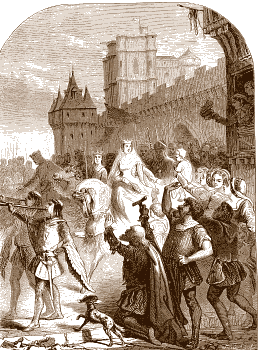
Robert Fawtier- The Capetian Kings of France- Monarchy and Nation (987-1328)
#xiii#robert fawtier#the capetian kings of france#blanche de castille#queens of france#regents#louis viii#louis ix#philippe ii#constance d'arles#robert ii#henri i#anne de kiev#philippe i#bertrade de montfort#adélaïde de savoie#louis vii#étienne de garlande#st bernard#aliénor d'aquitaine#adèle de champagne
4 notes
·
View notes
Text
Aulnoy's famous fairytales: The White Doe (2)
Now that we made a recap for the overall story, let's look at little details here and there, shall we?

1 ) Despite this being one of the most famous and reprinted fairytales of d'Aulnoy, The White Doe/The Hind in the Woods is one of the more dated of these stories. Not just because of the problematic racist elements of "princess Black of Ethiopia", but also because this story was clearly written in honor and reference to the king of the tme, Louis 14. When the fairies create a palace for princess Desired to live into until her fifteenth birthday, and have inside of it the whole history of the world depicted by art pieces, d'Aulnoy breaks her narration to describe in a poem form the "greatest and most brilliant warrior king of History", who is not named but is very clearly Louis XIV. Earlier, when the queen visited the six fairies' palace, the fairies told her that to build it they hired "the architect of the Sun", who basically recreated "the Sun's palace" but in smaller proportions. This is an obvious reference to Versailles, the wonderful castle of the "Sun-King", Louis 14. And if this wasn't enough, there are also several explicit comparisons to an actual historical event contemporary to the story: a royal wedding. Several times throughout the narration, d'Aulnoy says that the beautiful clothes or gorgeous outfits of Desired are identical with or "right behind in term of beauty" to the outfits and jewels worn at a "certain princess" wedding. These are all comparisons made to a certain woman named Marie-Adélaïde de Savoie, who had just married the duke of Bourgogne, aka... Louis XIV's grandchild.
All of this makes the story feel very NOT "intemporal" since, if you don't have the historical context, all those moments seem a bit weird and mysterious. And yet, this fairytale stayed one of d'Aulnoy's most popular ones... My guess is that what seduced people in this story was the imagery it brought rather than the story or writing itself. People's mind and imagination were struck by the supernatural white doe a prince cannot capture, by the visual of this monstrous crayfish terrorizing a queen and fairies by cursing a baby, by the idea of a beautiful girl doomed to live in the dark until her fifteenth birthday...
In fact, the way madame d'Aulnoy writes this tale to celebrate the royal wedding might explain why the main protagonist here, Desired, has such a young age - barely fifteen. Because Marie-Adélaïde de Savoie, upon being wed to Louis XIV's grandchild, was only twelve... [Note however that madame d'Aulnoy did not condone or enjoyed at all child-weddings of this sort - she herself had suffered from an atrocious arranged wedding in her very early life, and this ended up in a complicated business of manipulations, false accusations, exiles and murders - but when you live in 17th century France, you better be a propagandist of the king, especially if you are a woman who tries to write fiction.]
2 ) The beginning of the fairytale is obviously to put in parallel with Perrault's Sleeping Beauty. Same "gift-giving christening by the fairies" scene, the same way the older and more powerful of the fairies arrives to curse the babe only to have her curse "eased" by the others, the list of gifts offered by the fairies being quite similar to the one of the Sleeping Beauty fairies - more explicitely, in the beginning of Sleeping Beauty it was explicitely said the queen visited/tried several miraculous/healing waters to try to have a baby - which is what the queen does in the beginning of this tale, except here it becomes the start of the plot.
3 ) While there is still the manichean divide typical of French literary fairytales of "good fairy and wicked fairy", here d'Aulnoy plays deliberately on the fairies ambiguity, to show that despite acting by a binary pattern, fairies stay a "gray" set of beings. For example, the Fairy of the Fountain or Crayfish Fairy, despite being one of the main antagonists, starts out in the story as a helper and a benevolent force - and in a twist, still does fulfill her role of "good fairy godmother"... but she does so to the princess Black, who is an unwilling/accidental antagonist to the hero of the tale. (A similar process, where the antagonistic fairy is just the fairy godmother of someone other than the hero, was already used by d'Aulnoy in several of her previous fairytales, including The Blue Bird). As for the six benevolent fairies, while they are all good and nice throughout the story, the narration still highlights that they have two sets of chariots, and that when angered they drive the dragons, snakes and panther-driven chariots, hinting that while they are here helpers they can become antagonists in other stories.
4 ) While there is all the racism I talked about before, it is quite interesting to see here that we have two "anti-portraits" of ugly women, meant to oppose Desired's supreme beauty, two anti-portraits that actually help us understand the beauty criteria at work in this end of the 17th century of France. For Princess Black, we see that her ugliness comes from a "dark skin", "big lips" and a "crushed, large nose" - which are, beyond traits typically "African connoted", the opposite of the French ideal of women with very pale skin, very small noses, very thin lips. But in contrast, we also have Long-Thorn who presents another set of flaws. Just like princess Black there is the nose - here too red and too hooked - but beyond that we also have added poor teeth hygiene (Long-Thorn has black and unaligned teeth), and more interestingly a body too tall and too skinny. In general, when it comes to ugliness d'Aulnoy typically invokes smallness/dwarfism or fatness/obesity, but from time to time she also insists that when a character is too tall or too skinny, they also are ugly. Because in this time era, while they wanted women tall, they still didn't want them as tall as men, and there was still a certain "interest in the curve" as without being very large or big, women needed to be plump and fleshy enough to have a body to appreciate (a bony and skinny body was not a beautiful one at the time). Of course, no need to remind you that this was a set of aristocratic ideals - because only the noble and the rich could afford to be chalk-white and "pleasantly plump".
5 ) People have noted that, funnily, the way prince Warrior falls asleep in the woods after eating apples he found there looks like a "male Snow-White". It is quite interesting because, while there probably wasn't a Snow-White reference (since it is not a typically French tale), madame d'Aulnoy had the very Christian background and culture of the apple as the "forbidden fruit" with the whole Garden of Eden story. Which leads to an interesting point...
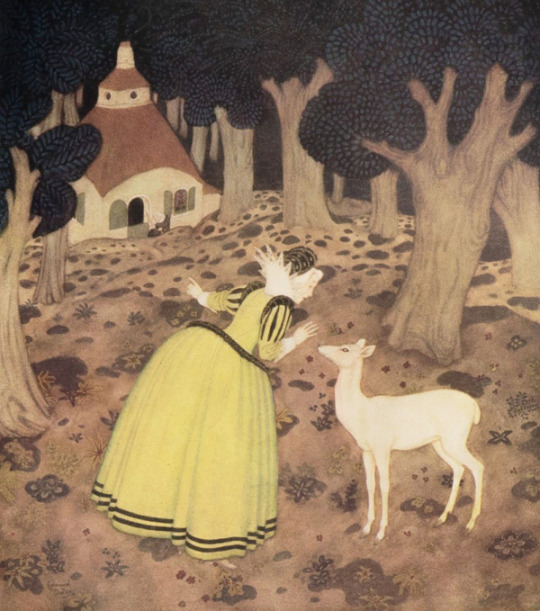
6 ) This fairytale is a sexy tale. It is not an overtly erotic fairytale, no, but there is an obvious VERY romantic if not sexy if not erotic connotation. This however only appears in the second half of the story, when Desired becomes the White Doe. Desired, turned into a prey, and Warrior, improvising himself a hunter, those two lovers, find themselves reunited deep into the woods (the uncivilized, savage, wild world) after purposefully leaving or fleeing their respective courts (the forest is noted to be filled with dangerous predatory animals, such as bears or lions). Warrior hunts down the White Doe, not knowing that she is the girl he is in love with and obsessed over - though he also grows a fondness, familiarity and love for this white doe. And all the while, the White Doe recognizes her hunter as the one she is in love with, and having to flee from him for her life is said to be just as painful as if she was actually hit by his arrows... Madame d'Aulnoy clearly plays here on metaphors and allegories to weave a whole "game of love" or "love as the hunt", "hunt as the love" section. Warrior hunting for the White Doe, the White Doe making sure she can be hunted while never letting herself be caught, it all evokes a bizarre game of seduction. Warrior clearly treats the Doe as more than a simple pet, claiming he "loves" it and wants it to follow him everywhere and to live with him. When the Doe tricks Warrior to escape him, and Warrior complains to his friend, Becafigue jokes about the situation being like an unfaithful woman cheating on her lover - but the prince answers his joke absolutely seriously. And of course, it is after the prince and the princess spend the night together, sharing their love, in human form, that the spell is broken... [Note: In my previous recap I might have written things backward, saying the spell is broken when "night comes and nothing happens". It is the reverse - they talk all ight long together, and as the morning comes she doesn't transform. Sorry about that.]
Beyond the general image, if things weren't clear eough d'Aulnoy keeps addng little details that make the story even more erotic - almost scandalous. The apple section I mentionned - prince Warrior eating apples in the woods before falling deeply asleep reminds of the first human consuming the "forbidden fruit", and it is when the White Doe dares sleep near him for the first time. When the prince catches the Doe or tries to "woo" it with gifts, it is said he keeps petting it, hugging it, caressing it, kissing it - as a pet, as an animal of course, but we reader know that there is a human woman underneath this doe skin, and so the erotic content cannot be escaped. ESPECIALLY when it is said that, after running from each other all day long, both return to their respective bedrooms "sweating and panting, exhausted by the time they spent together". And don't even get me started on how the prince ends up, to conquer and tie up the doe, hitting her with a single arrow in the leg, making her bleed... This is not a fairytale safe for kids.
7 ) Speaking of love, I did not mention it in my recap, but this fairytale is one of the rare ones of d'Aulnoy to have a moral in the end. To summarize it, d'Aulnoy explains that "With the story of this princess that wanted to leave too soon the dark place a wise fairy placed her in to hide her from the sun's light - and the metamorphosis and misfortunes that resulted from it - you will find an illustration of the dangers to which a young beauty exposes herself when she enters too young, too unprepared in the world. If you were gifted with all the traits and qualities that attract love to you, you better know how to hide them, because beauty can be deadly. If you think that by making others fall in love with you, you will shield yourself from love, well know that by giving too much, you always end up taking." So yes, long story short, this is meant to be more than just a fairy love story, but a warning for girls that too young, too beautiful, too unprepared, throw themselves in the world of love, adult and serious romance, and have to be confronted with the many dangers in it.
8 ) On a more "traditional love story" side, this fairytale accumulates ALL the story devices typical of romances of the type to avoid having the two lovers meet each other. In fact, this is the entire point of this story, the apex and climax and culmination: when princess Desired and prince Warrior can finally see each other in person, and talk to each other. At first you had the exchange of portraits and the sending of ambassadors, then you had the fake princess Long-Thorn hijacking the planned meeting, then the two lovers finally got under the same roof, but not only ignored each other's existence, even when meeting each other they didn't recognize themselves thanks t the doe curse... So when they finally see themselves as humans and touch each other as humans and talk a full dialogue, the story is complete and the curse is broken

9 ) Note however that despite the seemingly virtuous and chaste moral added at the end, madame d'Aulnoy does write the character of a more proactive and manipulative princess that "plays" her male lover. It is she that is happy with his caresses and petting and allows herself to be "touched" of the sort, and it is she that sneaks up by her lover's asleep body, and again the terms of the curse are clear - by day she is forced to become a beast, and to do as beasts do, aka to wander in the woods, aka to return to the world of savagery, primal desire and bestial behavior. On the other side, something that might escape a reader at first glance is that prince Warrior is not supposed to be a "prince Charmng" of the traditional genre. As I said, we are inside d'Aulnoy's second book of fairy tales, and so she reached a point where she plays with the conventions of the genre. In the whole hunt story, we have a brutal lover who tries to kill, seriously wounds though he heals it afterward) and ties up with knots his lover, treating her like a prey and a beast (well, because she IS, but you know) - and there is also the use of the peep-hole by Becafigue that solves the whole problem indeed, but by the undignified way of spying into women's bedrooms (Becafigue had already a not so good behavior when he acted as Warrior's ambassador, encouraging Desired's parents to ignore the "powerless" and "silly fairies" and disobey Tulip's warnings - and in the world of fairy tales one should NEVER underestimate the power of fairies)
But that's just for the second part of the story. In the first part, prince Warrior's behavior is also to be criticized. In fact, it is quite ironic that he is called "Warrior" and introduced as the winner of "three battles", because the first part of his character act has him acting as un-warrior, if not un-manly as possible. He becomes a love-stricken mess, he locks himself in his room talking to a portrait, he despairs of not being able to be with his love, he spends his day dreaming, and doing nothing, and wasting away, with no appetite for anything, making himself sick over lethargy and depression - and so fragile that he can't even wait three months for his loved one to come without fearing he would die. And even worse, when his hopes and dreams of love are crushed, he acts as a selfish coward by simply abandoning his parents, his throne, his court and duties, leaving secretly at night with just one letter behind to explain everything to his parents, and isolating himself from the world in desire to just cry on his own fate forever in some isolated place... We've got some emo teen in love vbes here.
10 ) This fairytale is very "medieval" like in tone. Beyond the "fairy christening" scene that is reused everywhere ever since Perrault and inherits from similar medieval scenes, a la Perceforest, the entire topic of the hunter going after a supernatural, white animal he cannot capture is an iconic topos of medieval literature. Typically this doubles or is tied to the hunter meeting some mysterious woman in the woods, preferably near a fountain, who might take him to a wonderful palace - but this happens rather to Desired's mother, who meets a fairy at a fountain, and is then taken to the six fairies' magical castle.
11 ) In terms of folkloric inspiration, if we use the Catalogue Delarue-Tenèze (a local form of the ATU Index but exclusively covering French fairytales), this story is clearly a literary take on the story type 403, "The substituted fiancee", "The fake fiancee". More specifically, it is a literary take on the 403-B (characterized by the metamorphosis of the real fiancee replaced by a fake one), though there is one element typical of the 403-A (the fact that the prince falls in love with a portrait). While inspired by it, madame d'Aulnoy clearly adds several purely literary elements that make this story very unique. For example the scene of the "fairy-gifts" and the "fairy-curse" at Desired's birth, or the presence of a first fiancee for the prince in the person of the princess Black, two elements united by the character of the Crayfish Fairy or Fairy of the Fountain - this all comes from d'Aulnoy's mind, and is traditonnaly not found in French folktales. And this was clearly placed here only to complicate the originally straightforward story into something much more focused on a "twist-and-turn romance".
#the white doe#the hind of the woods#french fairytales#literary fairytales#french fairy tales#madame d'aulnoy#d'aulnoy fairytales#fairytale analysis
116 notes
·
View notes
Photo

1700s-1710s After François de Troy - Marie Adélaïde of Savoy, Duchess of Burgundy, wife of Louis, Dauphin of France
(Musée d'Art et d'Histoire, Geneva)
127 notes
·
View notes
Photo

Marie Adélaïde de Savoie (1685–1712), Duchesse de Bourgogne. 1710. Credit line: Gift of the Marquis de La Bégassière, 1963 https://www.metmuseum.org/art/collection/search/436520
#aesthetic#art#abstract art#art museum#art history#The Metropolitan Museum of Art#museum#museum photography#museum aesthetic#dark academia
4 notes
·
View notes
Photo

LES LUMIÈRES DE VERSAILLES #leslumièresdeversailles "La faveur personnelle du cardinal Fleury a inondé la France non seulement de proscriptions, mais d'expatriations." Louis de Rouvroy, duc de Saint-Simon, Mémoires 1--UNE IDÉE DE PEINTURE Louis XV, roi de France (1710-1774), par Alexis-Simon Belle, 1723. A la mort de Jacques II, lorsque son fils James Francis Edward Stuart est reconnu roi d'Angleterre sous le nom de Jacques III par Louis XIV, le Parisien Alexis Simon Belle - né le 18 janvier 1674 - devient le peintre de la cour de la nouvelle Prétendant jacobite. Il retourna plus tard dans son pays natal et travailla à la cour de France, créant un portrait du jeune Louis XV en 1723, conservé au château de Versailles. 2--UN PEU D'HISTOIRE MODERNE Devenu roi en 1715, le jeune Louis XV, surnommé le « Bien-Aimé », réinstalle, à partir de 1722, le gouvernement et la Cour au château de Versailles, abandonné depuis la mort de Louis XIV. Fils du duc de Bourgogne et de Marie-Adélaïde de Savoie, arrière-petit-fils de Louis XIV, Louis XV est dauphin à la mort de son père en 1712, puis roi à cinq ans, en 1715, à la mort de Louis XIV. Son éducation, dirigée par son gouverneur, le maréchal de Villeroy, et par son précepteur, le cardinal de Fleury... 3--UNE MUSIQUE D'UN BONHEUR CONTAGIEUX Jean Philippe Rameau, Chaconne from Les Indes Galantes. (Jerusalem Baroque Orchestra &Ensemble Caprice) https://youtu.be/XwoN0OY52Us Initialement, vers la fin du XVIe siècle, la chaconne est une chanson populaire à danser, à trois temps de caractère vif, originaire d'Amérique, pendant le vice royaume de Nouvelle-Espagne et introduite en Espagne par les marins. Transplantée ensuite dans d'autres pays d'Europe au début du XVIIe siècle, elle y devient une danse de caractère noble puis est abordée par les instruments, en orchestre ou solistes. C'est alors une pièce de grandes proportions, en mesure ternaire, lente et solennelle, basée sur la répétition et la variation d'un thème comprenant en général 4 ou 8 mesures avec reprise. https://www.facebook.com/groups/716146568740323/?ref=share_group_link https://www.instagram.com/p/CnwJJTHMrfU/?igshid=NGJjMDIxMWI=
1 note
·
View note
Text

1706 Lady, most probably 1706 Lady, most probably Marie Adélaïde of Savoy, Duchess of Burgundy by Nicolas de Largillière (National Gallery of Victoria - Melbourne, Victoria, Australia). From history-of-fashion.tumblr.com-image-615286388655587328; removed spots and creases. and fixed the edges of portrait's oval with Photoshop 2854X3410 @150 1.7Mj.
#1700s fashion#1706 fashion#late Louis XIV fashion#late Baroque fashion#Marie Adélaïde of Savoy#Duchess of Burgundy#Nicolas de Largillière#curly hair#bouffant coiffure#fripon curls#hair flowers#wrap#chemise#modesty piece#square neckline#clasps.brocade
60 notes
·
View notes
Photo
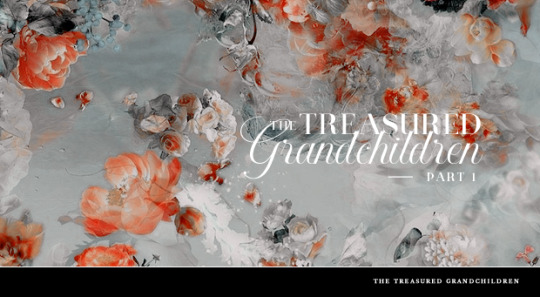


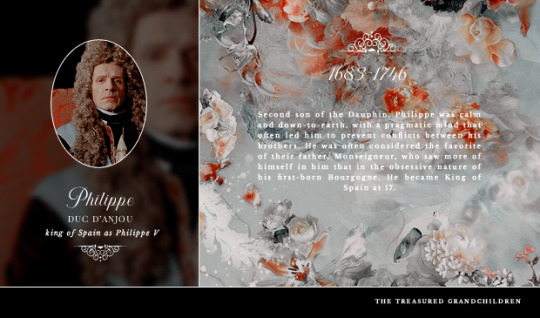

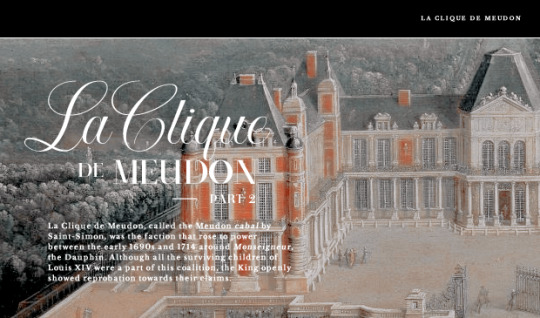

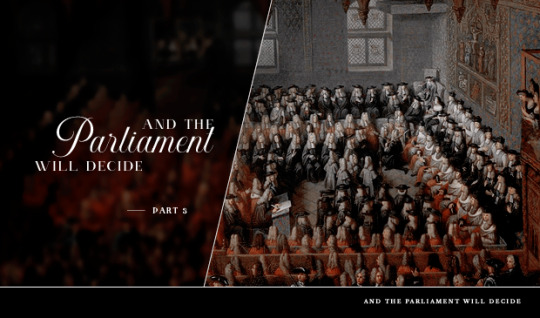
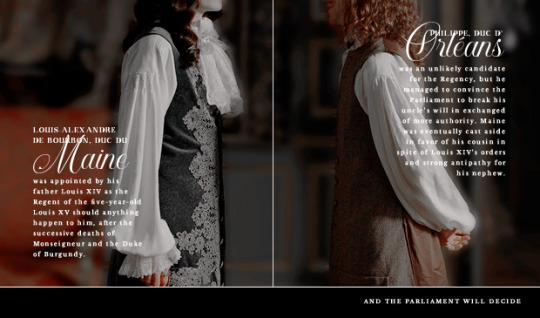

the descendants of Louis XIV
#historyedit#perioddramaedit#mine#louis xiv#louis xv#*#marie-adélaïde de savoie#louis de bourgogne#charles de berry#philippe d'anjou#monseigneur#*graphics
259 notes
·
View notes
Photo

Portrait of a lady, possibly Marie-Adélaïde de Savoie (1685-1712), Duchesse de Bourgogne, half-length, in an embroidered gold dress and a blue mantle (1705). Nicolas de Largillière (French, 1656-1746). Oil on unlined canvas, oval.
This impeccably-preserved, unlined canvas is remarkable in that the painted signature of Largillière can still be seen on the reverse of the canvas. It most probably depicts Marie-Adélaïde de Savoie, who became duchesse de Bourgogne when she married Louis, Dauphin of France and duc de Bourgogne, as part of the Treaty of Turin in 1696. She was the mother of the future King Louis XV of France.
77 notes
·
View notes
Photo
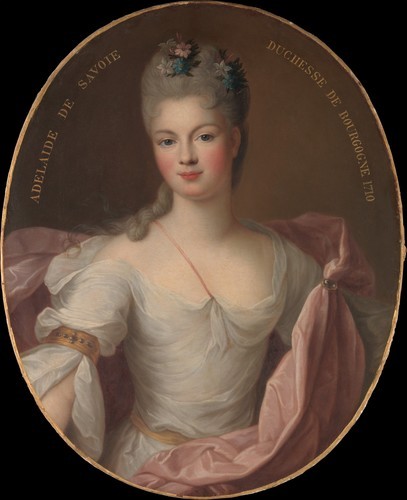
Marie Adélaïde de Savoie (1685–1712), Duchesse de Bourgogne, Pierre Gobert, 1710, European Paintings
Gift of the Marquis de La Bégassière, 1963
Size: Oval, 28 3/4 x 23 1/4 in. (73 x 59.1 cm)
Medium: Oil on canvas
https://www.metmuseum.org/art/collection/search/436520
17 notes
·
View notes
Photo

Leaf from a Book of Hours: Adoration of the Magi, Master of Thomas Hoo, c. 1440-1450, Cleveland Museum of Art: Medieval Art
Master of Thomas Hoo, also known as Master of Jean de Popincourt (France, Paris) Leaf from a Book of Hours: Adoration of the Magi (Office of the Virgin, Sext), about 1440-50 Ink, tempera, and gold on vellum The Jeanne Miles Blackburn Collection [Cat. no. 46] The artist of this miniature takes his name from a Book of Hours made for Thomas, Lord Hoo, chancellor of Normandy and of France, a volume now in the British Library, London. The Master of Thomas Hoo originally worked in Paris and then perhaps moved upstream to Rouen, following the retreat of the English armies during their occupation of France in the Hundred Years War. His style is characterized by a rich palette, lush draperies, and finely delineated landscapes. Gold leaf was thickly applied and the artist generally used liquid gold to highlight the hems of his figures' refined and elegant garments. The Adoration of the Magi, an important image in Christian tradition, recalls the first gentiles to recognize Christ. Just as the Three Magi often represent the three ages of man-youth, maturity, and old age-so their gifts had symbolic reference to key aspects of Christ's life. Gold symbolized his kingship; frankincense his priesthood; and myrhh, being used for embalming, stood for his Passion and death. Follower of the Master of Adélaïde de Savoie (France, probably Poitiers)
Size: Leaf: 20.2 x 14.4 cm (7 15/16 x 5 11/16 in.)
Medium: ink, tempera and gold on vellum
https://clevelandart.org/art/2011.60
8 notes
·
View notes
Quote
The strength of Louis and Françoise's relationship was their friendship. On this theme, Maintenon instructed Marie Adélaïde of Savoy in 1697 that her relationship would succeed by ensuring that the Duke of Burgundy became "your best friend and confidant."
Mark Bryant, Queen of Versailles: Madame de Maintenon, First Lady of Louis XIV's France
#Madame De Maintenon#louis XIV#history#historicalquotes#yes I'm sharing the fluffier stuff#but honestly this is a good bio so far#Like he doesn't shy away from talking about the more uncomfortable stuff#and discussing the different possibilities for it without excusing it
24 notes
·
View notes
Photo

1705 Nicolas de Largillière - Portrait of a lady, most probably Marie Adélaïde of Savoy, Duchess of Burgundy
(National Gallery of Victoria, Melbourne)
168 notes
·
View notes
Photo


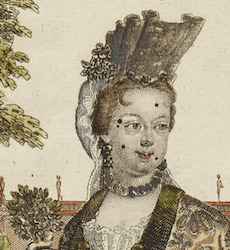
"Marie-Adélaïde de Savoie, Duchesse de Bourgogne" par Jean Mariette (circa 1700) présentée à la conférence “Le XVIIe Siècle à la Cour de France” par Julie Rohou - Conservateur du Patrimoine au Musée National de la Renaissance - Château d'Ecouen - pendant le cycle de cours d'été “De la Parure de Cour à la Joaillerie Parisienne : Une Histoire du Bijou” de l'Ecole du Louvre, juillet 2021.
#conferences#inspirations bijoux#bijoux de tête#illustrations#style#dentelle#végétal#Mariette#Rohou#EcoleLouvre#eventail
2 notes
·
View notes
Photo

A painting depicting Marie-Adélaïde de Savoie, duchesse de Bourgogne on the hunt; attributed to Pierre-Denis Martin, circa late 17th century.
183 notes
·
View notes
Photo

Marie Adélaïde de Savoie (1685–1712), Duchesse de Bourgogne
Pierre Gobert, 1710
81 notes
·
View notes
Text

Marie-Adélaïde de Savoie, mother of Louis XV
Marie-Adélaïde, Princess of Savoy, Duchess of Burgundy and Dauphine of France who was the wife of the grandson of the Sun King, the mother of Louis XV and who lit up Versailles with his Youth and Grace.
She was born on December 6, 1685. She is the eldest daughter of Anne-Marie d'Orléans and Victor-Amédée II of Savoy.
Louis XIV reached an agreement with Savoy and asked for the princess's hand for his eldest grandson Louis Duke of Burgundy born in 1682. Thus, Marie-Adélaïde vicariously married the heir to the crown on September 15, 1696 and in person December 7, 1697 just after having crossed the legal age to marry (12 years). Very quickly, the little duchess of Burgundy becomes the coqueluge of Versailles which she animates because of the advanced age of Louis XIV. He adores his granddaughter who often jumps on his knees even when he works and does not hesitate to touch everything she finds. Marie-Adelaide calls Madame de Maintenon "my aunt" and allows herself a thousand familiarities with her father-in-law, the Grand Dauphin. Some say she is a spoiled child, others that she is the sunbeam of the king and Versailles.
Her husband, the Duke of Burgundy, will devote her a real passion of love while she takes lovers when the young Louis is at war and rarely responds to his letters. Marie-Adélaïde attracts the remonstrances of Mme de Maintenon but she complains that her husband is too serious and always begs. However, after the military humiliation of the Duke of Burgundy, his wife began to truly love him and to support him in public.
Marie-Adélaïde nevertheless leads an infernal lifestyle by going to bed sometimes at dawn for having spent the night having fun and illuminate Versailles.
Soon the duchess becomes mother. On June 25, 1704, at first, she gave to Louis XIV her first great-grandson, the Duke of Brittany. Although she is very young and entirely delegate her "duty" of mother to the nanny of the child, she shows a real sorrow when her son died of convulsions on April 13, 1705. On January 8, 1707, she puts in the world a second duke of Brittany then on February 15, 1710 the little duke of Anjou (future Louis XV). Marie-Adélaïde becomes Dauphine at the brutal death of the Grand Dauphin on April 14, 1711 and finds herself on the front of the stage with her husband who is already preparing to reign. Became the first lady of the kingdom, she is very jealous of the illegitimate girls of Louis XIV the Princess of Conti and the duchesses of Bourbon and Orleans. The Dauphine does not care, she keeps repeating "I would be theirs queen »
However, Marie-Adélaïde will never become queen of France. She died sudden on February 12, 1712 leaving an inconsolable husband who also victim of the disease is let die and follows in death on February 18. The duchess once asked her husband who he would marry if she died before him. The Duke of Burgundy would have responded to Marie-Adelaide that he would not remarry because he also died within eight days ... he kept his promise.
The death of the Dauphine was the greatest sorrow of Louis XIV. But the death that fell on his family was not over because on March 8 of the same year the Duke of Britain baptized Louis also succumbed.
All that was left of the young Dauphine was a frail 2-year-old, who was also sick and no one would ever bet he could be king one day. With the death of Marie-Adélaïde of Burgundy, Princess of Savoy, it is all the joy and the celebrations that left Versailles to return only under Louis XV.
#louis xv#marie adelaide de savoie#savoy#france#savoie#versailles#king#duchess#princess#dauphine#queen#history#european history#short history#painting#XVII#mother#louis xiv
1 note
·
View note